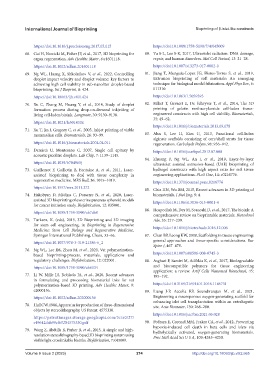Page 282 - IJB-9-2
P. 282
International Journal of Bioprinting Bioprinting of β-islet-like constructs
https://doi:10.1016/j.precisioneng.2017.05.015 https://doi:10.1088/1758-5090/7/4/045009
68. Cui H, Nowicki M, Fisher JP, et al., 2017, 3D bioprinting for 80. Yu S-L, Lee S-K, 2017, Ultraviolet radiation: DNA damage,
organ regeneration. Adv Healthc Mater, 6:e1601118. repair, and human disorders. Mol Cell Toxicol, 13: 21–28.
https://doi:10.1002/adhm.201601118 https://doi:10.1007/s13273-017-0002-0
69. Ng WL, Huang X, Shkolnikov V, et al., 2022, Controlling 81. Jiang T, Munguia-Lopez JG, Flores-Torres S, et al., 2019,
droplet impact velocity and droplet volume: key factors to Extrusion bioprinting of soft materials: An emerging
achieving high cell viability in sub-nanoliter droplet-based technique for biological model fabrication. Appl Phys Rev, 6:
bioprinting. Int J Bioprint, 8: 424. 011310.
https://doi:10.18063/ijb.v8i1.424 https://doi:10.1063/1.5059393
70. Xu C, Zhang M, Huang Y, et al., 2014, Study of droplet 82. Billiet T, Gevaert E, De Schryver T, et al., 2014, The 3D
formation process during drop-on-demand inkjetting of printing of gelatin methacrylamide cell-laden tissue-
living cell-laden bioink. Langmuir, 30: 9130–9138. engineered constructs with high cell viability. Biomaterials,
35: 49–62.
https://doi:10.1021/la501430x
https://doi:10.1016/j.biomaterials.2013.09.078
71. Xu T, Jin J, Gregory C, et al., 2005, Inkjet printing of viable
mammalian cells. Biomaterials, 26: 93–99. 83. Ahn S, Lee H, Kim G, 2013, Functional cell-laden
alginate scaffolds consisting of core/shell struts for tissue
https://doi:10.1016/j.biomaterials.2004.04.011 regeneration. Carbohydr Polym, 98: 936–942.
72. Demirci U, Montesano G, 2007, Single cell epitaxy by https://doi:10.1016/j.carbpol.2013.07.008
acoustic picolitre droplets. Lab Chip, 7: 1139–1145.
84. Zhuang P, Ng WL, An J, et al., 2019, Layer-by-layer
https://doi:10.1039/b704965j ultraviolet assisted extrusion-based (UAE) bioprinting of
73. Guillemot F, Guillotin B, Fontaine A, et al., 2011, Laser- hydrogel constructs with high aspect ratio for soft tissue
assisted bioprinting to deal with tissue complexity in engineering applications. PLoS One, 14: e0216776.
regenerative medicine. MRS Bull, 36: 1015–1019. https://doi:10.1371/journal.pone.0216776
https://doi:10.1557/mrs.2011.272
85. Chia HN, Wu BM, 2015, Recent advances in 3D printing of
74. Hakobyan D, Médina C, Dusserre N, et al., 2020, Laser- biomaterials. J Biol Eng, 9: 4.
assisted 3D bioprinting of exocrine pancreas spheroid models https://doi:10.1186/s13036-015-0001-4
for cancer initiation study. Biofabrication, 12: 035001.
86. Hospodiuk M, Dey M, Sosnoski D, et al., 2017, The bioink: A
https://doi:10.1088/1758-5090/ab7cb8
comprehensive review on bioprintable materials. Biotechnol
75. Turksen, K. (eds), 2015, 3D Bioprinting and 3D imaging Adv, 35: 217–239.
for stem cell engineering, in Bioprinting in Regenerative https://doi:10.1016/j.biotechadv.2016.12.006
Medicine: Stem Cell Biology and Regenerative Medicine,
Springer International Publishing, Cham, 33–66. 87. Chan BP, Leong KW, 2008, Scaffolding in tissue engineering:
https://doi:10.1007/978-3-319-21386-6_2 general approaches and tissue-specific considerations. Eur
Spine J, 467–479.
76. Ng WL, Lee JM, Zhou M, et al., 2020, Vat polymerization-
based bioprinting-process, materials, applications and https://doi:10.1007/s00586-008-0745-3
regulatory challenges. Biofabrication, 12: 022001. 88. Asghari F, Samiei M, Adibkia K, et al., 2017, Biodegradable
https://doi:10.1088/1758-5090/ab6034 and biocompatible polymers for tissue engineering
application: a review. Artif Cells Nanomed Biotechnol, 45:
77. Li W, Mille LS, Robledo JA, et al., 2020, Recent advances 185–192.
in formulating and processing biomaterial inks for vat
polymerization-based 3D printing. Adv Healthc Mater, 9: https://doi:10.3109/21691401.2016.1146731
e2000156. 89. Liang J-P, Accolla RP, Soundirarajan M, et al., 2021,
https://doi:10.1002/adhm.202000156 Engineering a macroporous oxygen-generating scaffold for
enhancing islet cell transplantation within an extrahepatic
78. Hull CW, 1986, Apparatus for production of three-dimensional site. Acta Biomater, 130: 268–280.
objects by stereolithography. US Patent. 4575330.
https://doi:10.1016/j.actbio.2021.05.028
https://patentimages.storage.googleapis.com/5c/a0/27/
e49642dab99cf6/US4575330.pdf 90. Pedraza E, Coronel MM, Fraker CA, et al., 2012, Preventing
hypoxia-induced cell death in beta cells and islets via
79. Wang Z, Abdulla R, Parker B, et al., 2015, A simple and high- hydrolytically activated, oxygen-generating biomaterials.
resolution stereolithography-based 3D bioprinting system using Proc Natl Acad Sci U S A, 109: 4245–4250.
visible light crosslinkable bioinks. Biofabrication, 7: 045009.
Volume 9 Issue 2 (2023) 274 http://doi.org/10.18063/ijb.v9i2.665

